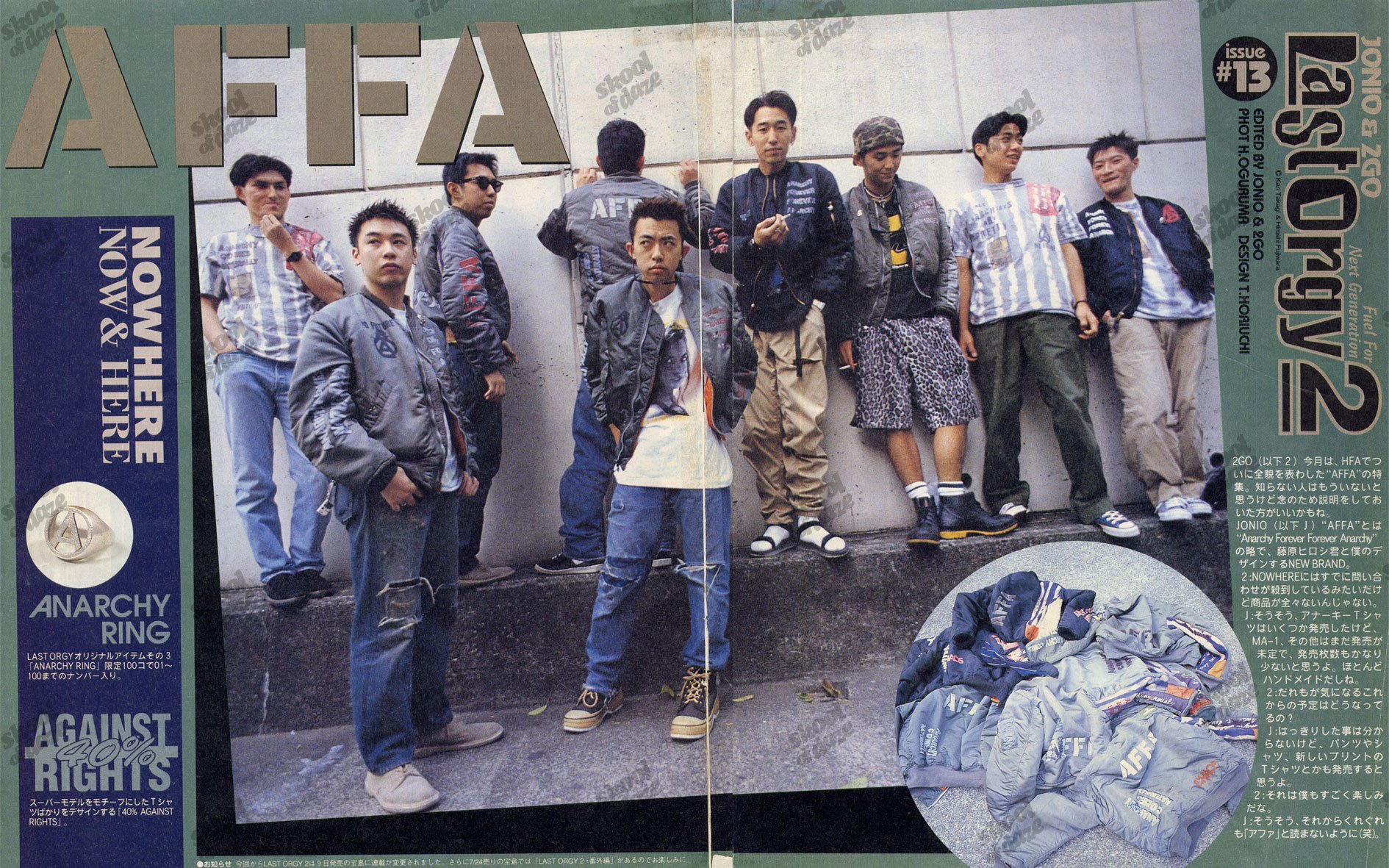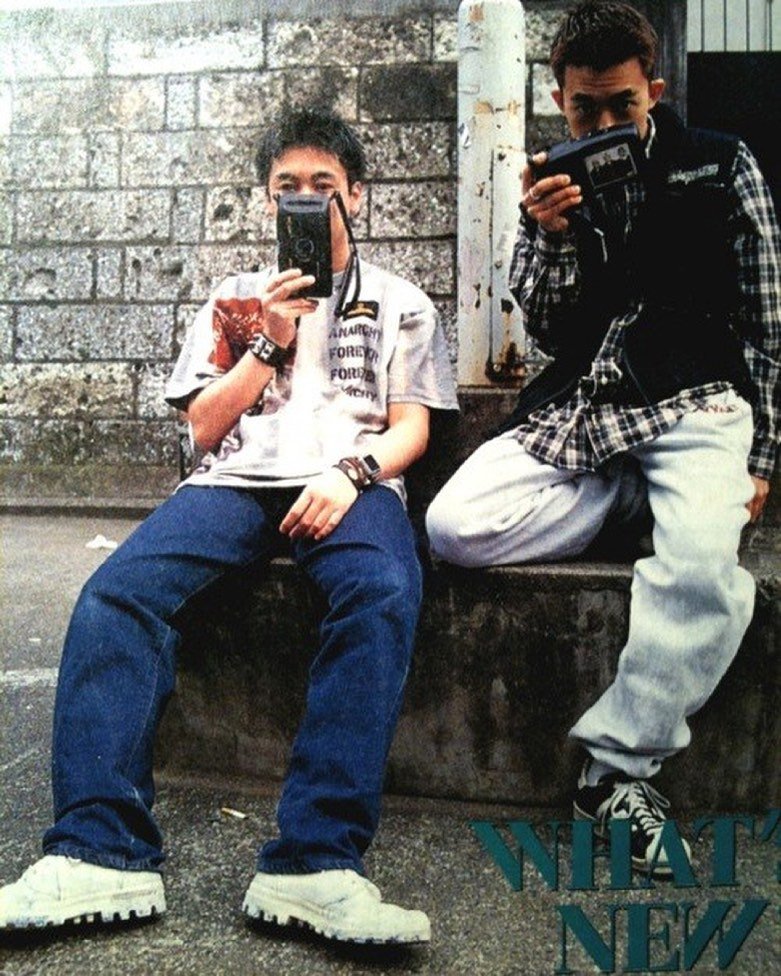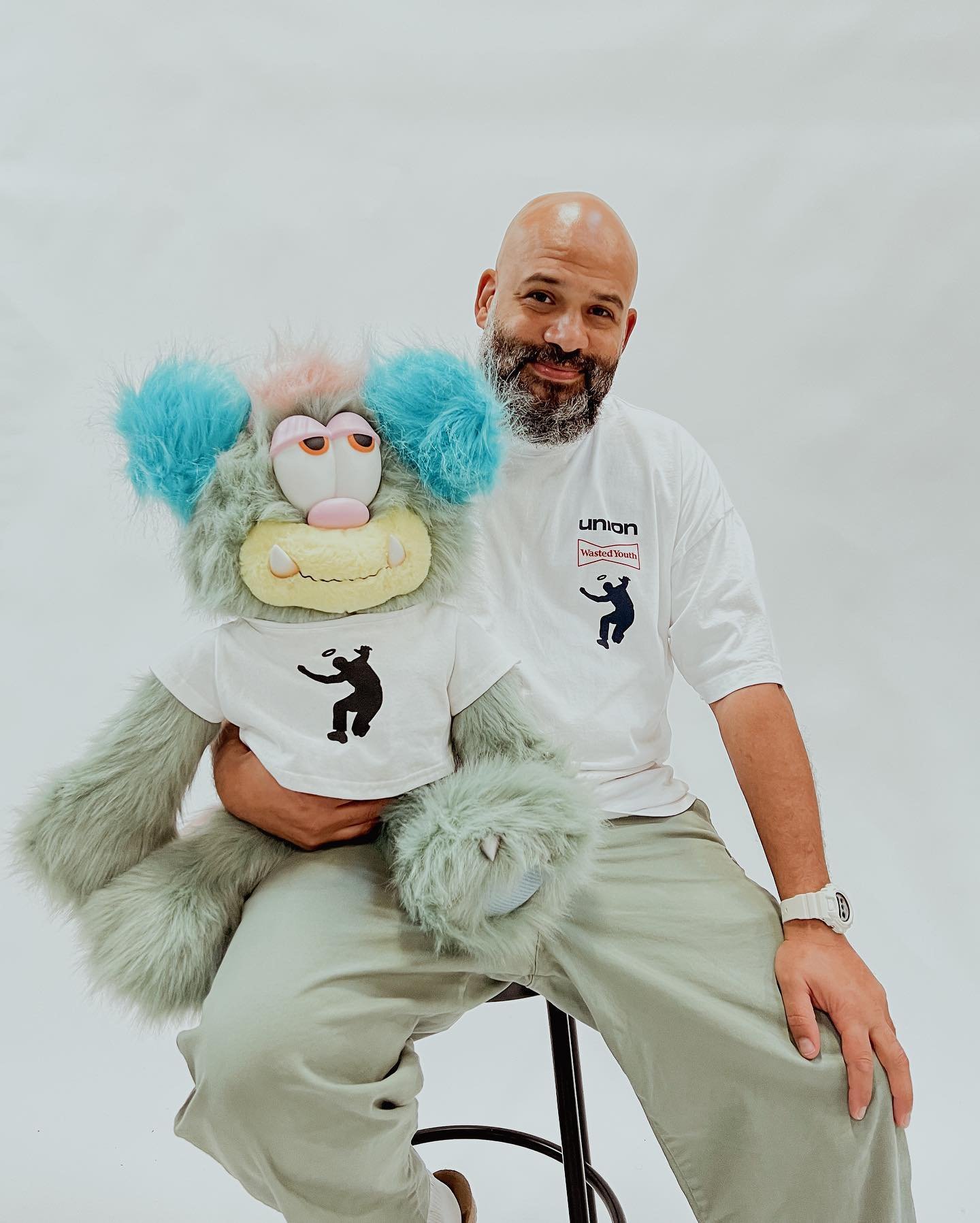Last Orgy: Tracing Down The Legacy Of Japan’s Most Important Fashion Column

Japan is one of the leading countries not only in streetwear, but fashion in general. Everyone looks to Japan, Tokyo especially, for trends, inspiration, and influences. Style here has an effortlessly cool ambiance to it, where each and every detail matters. Here, fashion is not just about the brands or pieces you are wearing, but an entire image you portray of yourself.
This essence has not changed since the late 80s and early 90s, Japan’s golden age of streetwear. We’ve obviously covered numerous topics that revolve around Ura-Hara before. The birthplace of some of the most influential streetwear brands like BAPE, Neighborhood, WTAPS, and UNDERCOVER came out of the Ura-Hara scene, and without it, streetwear today would never have been the same.
Ura-Hara effectively refers to the small back alleys of Harajuku, where small brands harnessed the power of the west’s style and re-engineered it in their own respective ways. Ura-Hara was a collective; a culmination of fashion, music, and media that all pointed in one direction, yet also seamlessly branched out to different subcultures naturally. It was freedom, creativity, and rebelliousness, and through it molded streetwear into what it is today.
Ura-Hara truly opened up Tokyo, opened up Japan, to the rest of the world. Connecting the East and West through graphic tees, collectible sneakers, iconic collaborations, and anything in between. The era set the foundation of all streetwear we know and love today. However, before Ura-Hara there was something even more influential. Something that is said to have birthed Ura-Hara. Ask anyone that was around in that era, and they will tell you that all signs point to one thing when it comes to the origin of Ura-Hara – Last Orgy.
One of most influential things the fashion world has ever been blessed with, Last Orgy is the infamously confused [in the West] column in magazines, which although its stature in the history of streetwear, is often overlooked and forgotten about.
Because of this, we are taking a deep dive into the history of this serialization that through its power had shelves running out of stock, had kids listening to never before heard sounds, and created a collective that still holds up streetwear on their shoulders today.
The Founder of Streetwear
First of all, to understand why this magazine was and still is often overlooked is because of the lack of concrete information out there for the West. It is infamously misreported on, with parts of information missed out and filled in with falsehoods. This means the history has been skewed, although it all started with two men: Hiroshi Fujiwara and Kan Takagi.
Hiroshi, often known as the man who connected the East to the West when it comes to streetwear, is a musician and designer, founder of the well-known brand Fragment and GOODENOUGH, and was behind many other projects that kicked off during that time.To first understand why Last Orgy was so impactful to the next generation of Japan’s youth, we first need to briefly dive into why Hiroshi was so influential.
Hiroshi, an avid punk rock fan since his teens, would travel to London where he could immerse himself in the genre and culture there. After his travels, and being the roommate of Boy George from Culture Club, he would further expand his travels to New York where he would first experience the exploding popularity of Hip-Hop at the time. Experiencing these different cultures first hand would also open him up to the fashion, meeting important people such as Shawn Stüssy. This really widened his spectrum of fashion, and he became what we would know now as a kind of living internet of the West.
When returning, Hiroshi would bring back with him hip-hop vinyl’s never heard before in Japan, and opened up the Japanese community to this sound. Through this, he became one of the pioneers of hip-hop in Japan, a now extremely popular genre. He went on to create a hip-hop duo with Kan Takagi named Tinnie Punx [also stylized as Tiny Panx], and would become one of the first hip-hop groups in Japan.
The First Orgy
In 1988 Tiny Panx released the song Last Orgy on the Japanese record label, Major Force. Gaining mass amounts of popularity, Tinnie Punx would be invited to start a column in the Japanese publication, Takarajima [Treasure Island]. Focused mainly on subcultures, Takarajima was a cult-classic magazine, and in a time where Instagram moodboards and social influencers were light years away, this was the pinnacle of inspiration for much of the youth at the time.
Hiroshi and Kan’s column would be named ‘Last Orgy’ based off of their song and would consist of simply putting in whatever they felt like at the time. They would talk about fashion, films, or what music they were listening to. Anything subculture related was inside Last Orgy, and it became the go to thing that kids looked at for inspiration. Whatever things that were mentioned would sell out the next day or become the next big thing. Without them knowing, Hiroshi and Kan would be orchestrating what we know today as streetwear culture. Last Orgy would eventually become so popular that the column would become a TV show, airing on FM-TV in Japan, which featured the same content but this time in video.
The influence was so great that it even birthed one of Japan’s biggest streetwear legends, NIGO. Originally known as Tomoaki Nagao, the young streetwear fan would record each episode of Last Orgy. Last Orgy influenced NIGO’s decision to move to Tokyo and enrol at the Bunka Fashion College, where he met the aspiring designer Jun “Jonio” Takahashi and started the next chapter of Last Orgy.
Last Orgy 2
NIGO would meet Jonio [Jun Takahashi of UNDERCOVER] when at Bunka Fashion College, and the two would hit it off instantly. Both sharing a passion for streetwear created by the Last Orgy column, the two would meet Hiroshi along their way and this would also be where NIGO’s name would originate from. NIGO, meaning ‘number 2’ is due to his striking resemblance to Hiroshi.
NIGO and Jonio, through their influence, would be invited to succeed Hiroshi and Kan with their own column in the same magazine. Originally titled ‘AZ’ in 1991, it would soon become ‘Last Orgy 2’. Still remaining in the magazine Takarajima, it would later also be in another magazine, Asayan; a fashion magazine which again was the hot spot of influence for the youth of Japan.
It was an iconic piece of literature during the 90’s and allowed NIGO and Jonio to once again, much like their predecessors, talk about streetwear culture and everything that orbited it. From fashion to music, films to parties, Last Orgy 2 was the piece of content to keep your eye out for.
This is when things really started to ramp up for streetwear. Everything that Jonio and NIGO would reference would sell out and resell values would shoot up in price starting a type of resell culture that is today, so apparent. If you saw something you like & want to buy in Last Orgy, it was most likely too late. To be able to actually get your hands on something shown in the series, you needed to have some sort of connections to the people in the scene, and get that information before it was published.Streetwear was booming in Japan at the time, and more and more brands around NIGO, Jonio, and Hiroshi’s circle would continue to build and grow, blossoming into the dominant streetwear brands we all love today.
GOODENOUGH, NOWHERE and the Ura-Hara Boom
Another extremely pivotal moment in streetwear, directly influenced by the column, was around the time of Last Orgy 2. In 1990, Hiroshi would start his brand, GOODENOUGH. This brand would harness the power of the growing streetwear scene created from Last Orgy, and it all started when SK8THING, the legendary Japanese graphic designer behind designs ranging from NEIGHBORHOOD, BAPE, and his own brand CAV EMPT, would float the idea of creating premium graphic t’s to Hiroshi. This store would be the catalyst for another pivotal moment in the Ura-Hara movement.
When GOODENOUGH was first introduced in the Last Orgy series, nobody knew who was behind it. In fact, most readers thought it was a brand from London. This was another one of Hiroshi’s tactics he often used, staying completely anonymous & hidden, rather than becoming the face of a brand. He also took part in many other brands/stores, just without ever going public with it. There are probably projects that he’s had a hand in, that only a small handful of people even in the Ura-Hara scene knew about.
Following in GOODENOUGH’s footsteps, both NIGO and Jonio would move on to start their own brands, BAPE and UNDERCOVER, and learning the ropes from Hiroshi’s, would open NOWHERE, a streetwear store which would stock both of their brands respectively.
NOWHERE would become the one stop shop for Japanese streetwear, and the nucleus of the Ura-Hara movement. It was a prime location to pick up the latest threads and a beacon of trends amongst the streets of Harajuku. This is where NIGO and Jonio would really start to pull the strings of the new age of streetwear. At first the store mainly consisted of vintage clothing curated by NIGO, and Jonio’s brand UNDERCOVER, but would go on to stock brands such as 40% Against Rights [designed by Sk8thing and WTAPS head Tet Nishiyama], and AFFA [ANARCHY FOREVER FOREVER ANARCHY], the label co-designed by Jonio and Hiroshi Fujiwara.
From this boom came similar stores such as NEIGHBORHOOD, named after its link to the Harajuku neighbourhood, Visvim, WTAPS, Goro’s and more. All household names now in the streetwear world. It is clear to see why this tsunami of streetwear culture became so impactful when we look at the type of brands that Ura-Hara birthed.
Last Orgy 3
Last Orgy 2 would eventually come to an abrupt stop in 1994, when Jun was busy working on the Autumn/Winter UNDERCOVER collection, as well as the magazine changing its name and art direction, so the column did not fit the style anymore. Although the pair made the announcement that Last Orgy 3 would eventually come back.
Last Orgy 3 would eventually reappear in Asayan, this time round containing all heads within the triad of Japanese streetwear: Hiroshi, Jonio and NIGO. Continuing the theme of talking about their current interests, Last Orgy 3 wouldn’t change the recipe of success that made Last Orgy 1 and 2 so impactful, just instead this time would bring together all 3 pioneers. Hardly any information is out there on Last Orgy 3, which makes it so unique and intriguing. Unless you have the actual magazines, then you are out of luck for knowing what was in Last Orgy 3.
Last Orgy 2.1
Now fast forward to 2021, Streetwear was bigger than ever. Once the newcomers setting the trends, Jun, Hiroshi, and NIGO are now the godfathers of streetwear. Still producing some of the most anticipated streetwear releases for the fashion-hungry youths, Last Orgy would make its long awaited comeback in this special series hosted on GQ-Japan. Named Last Orgy 2.1, due to Hiroshi not being a part of it, only NIGO and Jun, the revival column would once again consist of the legendary duo talking about pretty much anything: life experiences, current hobbies etc. Now no longer newcomers, but individuals who had solidified themselves within the history of streetwear, the conversations between the two are charming and oozes a sense of nostalgia.
Last Orgy 2.1 also brought in VERDY, artist, culture connector, and overall streetwear gentleman to design the Last Orgy logo in his signature font used in the ‘Girl Don’t Cry’ logo. Last Orgy 2.1 also saw new apparel being released under the pair's respected brands, UNDERCOVER and NIGO’s latest venture, HUMAN MADE. For the column they also curated playlists on Spotify, sharing music they enjoy listening to.
The column that changed history
It’s hard to imagine streetwear even existing without the power and influence of Last Orgy. In a time where the internet was not a thing, magazines were the vital source of information that allowed people to learn about new and upcoming trends and movements. It allowed the Japanese to hone in on their street fashion, opening them up to what we know today as their effortlessly cool style.
It wasn't only the Japanese that benefited from the column though. Streetwear for the west would have never been the same without brands such as BAPE, UNDERCOVER, and Fragment helping to pave the way. You ask anyone into streetwear what their favourite brands are, and 90% of the time amongst their roster there will be a handful of brands that started due to the Ura-Hara movement created by Last Orgy.
The greatest influencer the world of streetwear has ever seen, this magazine column goes down in history as being the most important factor in streetwear and reminds us that although things are as accessible as ever in this digitised work, nothing beats the words printed in-between the papers of a good magazine.
Words by Joe Goodwin
































